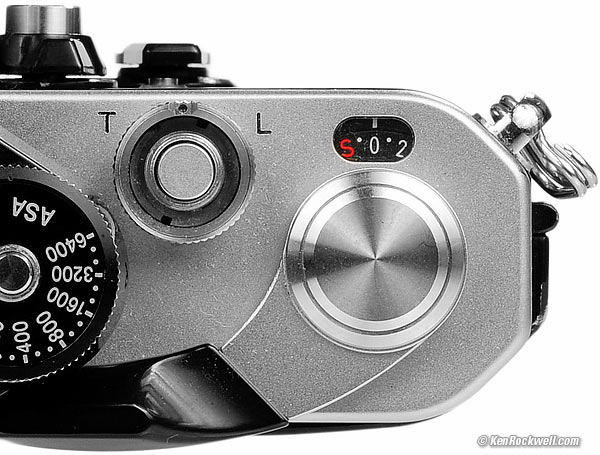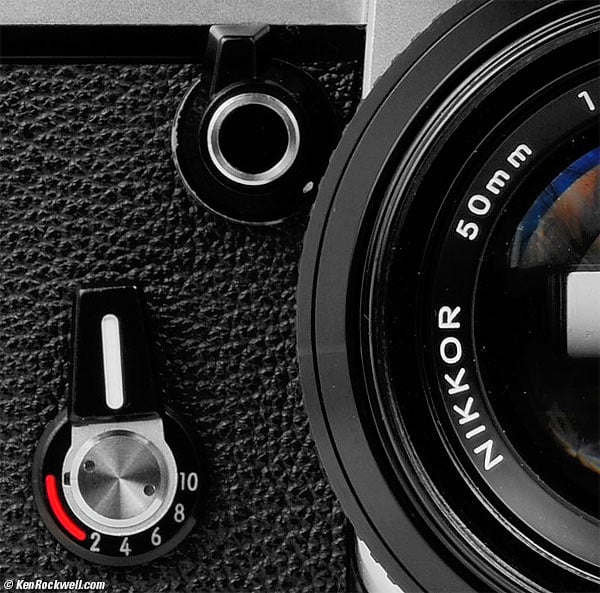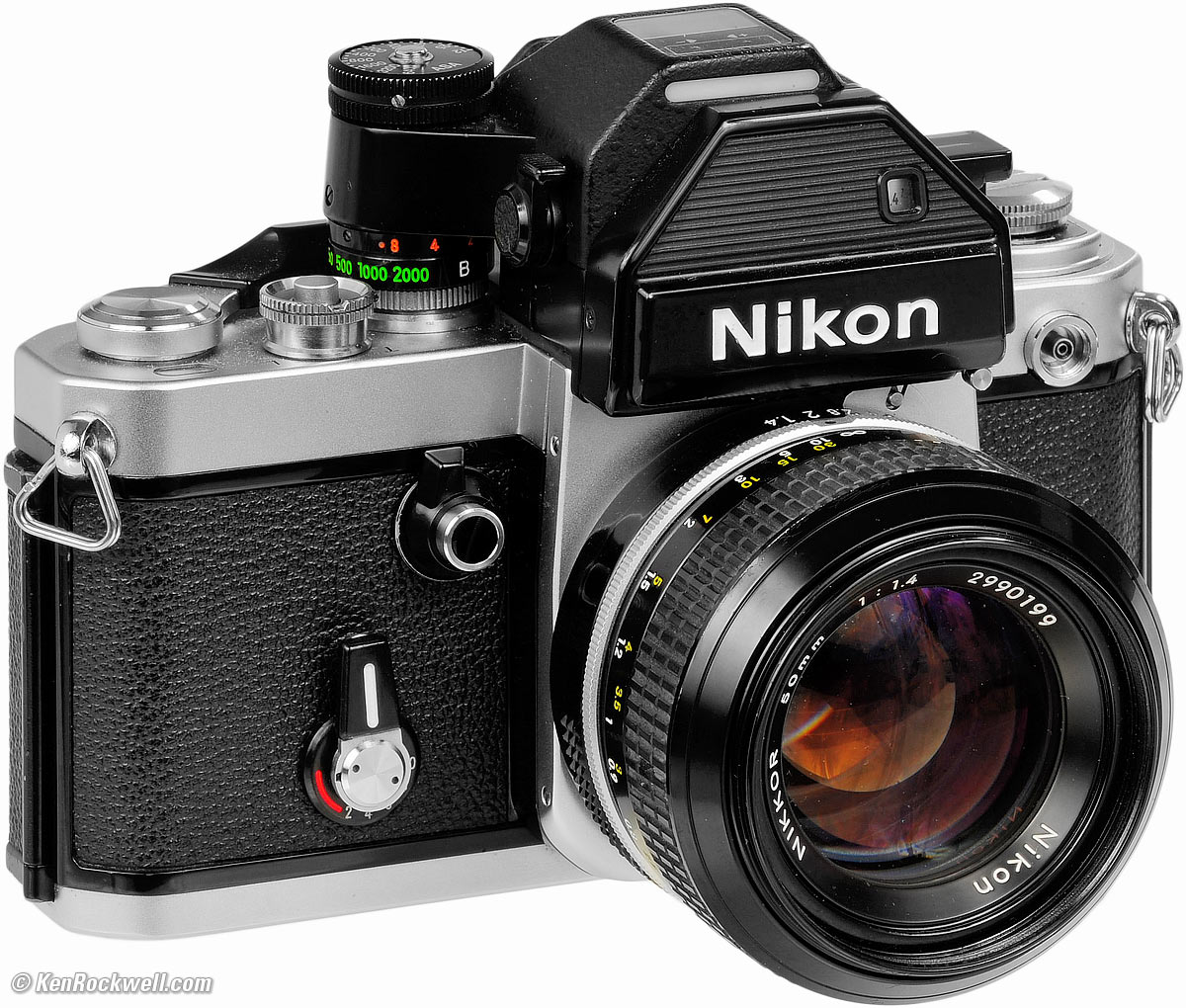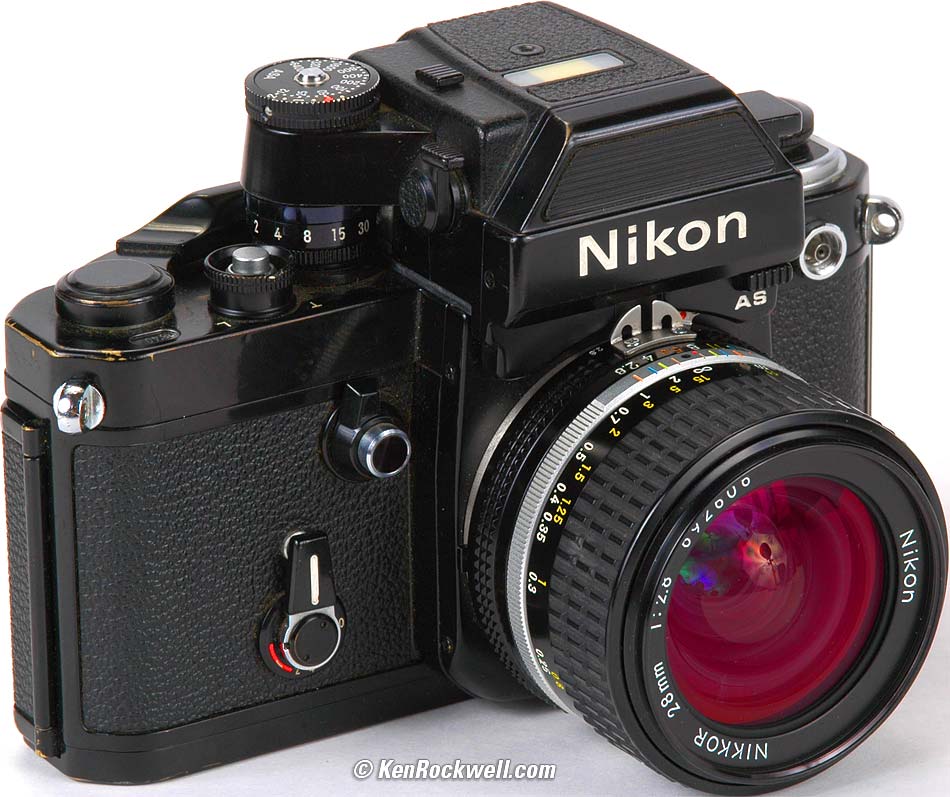Home Donate New Search Gallery Reviews How-To Books Links Workshops About Contact
Nikon F2 Cameras
Professional 35mm SLRs (1971-1980)
Nikon F2S Photomic (1/2,000 to 10 full seconds titanium-shutter mechanical 35mm SLR, two common A76 button cells for meter only, couples to Nikon F, AI and AI-s lenses , 31.5 oz./894g with batteries and film, about $175 used) and 1975 Nikon 50mm f/1.4. enlarge. I'd get them at this link to all versions of the NIkon F2 at eBay (see How to Win at eBay).
My biggest source of support for this free website is when you use those or any of these links when you get anything, regardless of the country in which you live — but I receive nothing for my efforts if you buy elsewhere. Please always use any of these links for the best prices and service whenever you get anything. Thanks for helping me help you! Ken.
April 2019 Better Pictures Nikon Reviews Nikon Lenses Nikon Flash All Reviews
Introduction top
|
I buy only from these approved sources. I can't vouch for ads below. |
All of the various versions of the Nikon F2 were the world's top professional 35mm SLRs from 1971 through 1980, and by some people's recollection, the top 35mm SLR of all time.
The Nikon F2 is so good that many photographers — including myself — preferred to pay more for used Nikon F2s in the early 1980s after they were discontinued than to pay less for a brand-new Nikon F3 with which Nikon replaced it. The Nikon F3 was electronic, and was not trusted to meet professional demands under all conditions. Time proved the F3 just as reliable, but in the early and middle 1980s, electronic cameras were deemed suitable only for amateurs. The Nikon F2 was the king of newspaper and magazine photography of the 1970s.
Its development in part was fueled by cameras developed for NASA for Apollo and SkyLab missions.
The Nikon F2 is an extraordinarily well made all-mechanical SLR. The F2 system includes all sorts of interchangeable finders, focus screens, 250-exposure backs and motor drives.
The original Nikon F of 1959 put LEICA in the coffin, and the F2 was the camera the almighty himself used to hammer in the nails. The F2 improved on the Nikon F, and LEICA's rangefinders were still just the same primitive rangefinders, thus the SLR versus rangefinder question for professional newsgathering was answered once and for all.
These Nikons are faster handing, more reliable, offer more accurate TTL metering and far more accurate focus and framing than anything once-great LEICA was offering then, and even today!
The F2 is so well made that every one I've seen still works perfectly, and has never required any service to stay that way. This is far better than LEICA, every one of which I've seen from this era has required service. It all comes down the lubricants. Nikon uses lubricants which seem to last forever, while LEICAs need to be cleaned out every 20 years because they get gummy or dried-out.
The F2 bodies come in black or silver.
All F2s have mirror lock-up and depth-of-field preview levers.
Power top
All F2 models take two common A76 button cells in their base to power any of the meter ("Photomic") heads.
These cells power only the meter, and last a year or more. The meter is switched on as you pull the wind lever away from the body. When the lever's pulled out, you'll see a red dot uncovered on the top of the body.
Push-in the wind lever, and the batteries are completely disconnected.
No batteries? No problems! The batteries power only the light meter. Everything else works perfectly without any batteries.
Shutter top
All Nikon F2s have horizontal titanium-foil shutters with 1/90 X-sync speeds.
Unique to the F2 is that the shutter speed is continuously variable between 1/90 and 1/2,000. That's why those speeds are in green.

Nikon F2S Shutter Button and Collar.
Every F2 also has both Bulb and Time exposure modes. For Time, rotate the collar around the shutter release to "T." Press the shutter, and it stays open forever, or until you move the collar away from T. The "L" around the collar is Lock.
Also unique to the F2 is a continuously variable self timer settable from 2 to 10 seconds:

Nikon F2S Depth-of-field Preview, Mirror Lockup and Self-TImer.
By deliberate design (this is in the user's manuals), the Nikon F2 is also unique in having manual shutter speeds out to 10 full seconds! They are continuously variable from 2 to 10 seconds. You use them by setting the shutter dial to B, rotate the shutter-button collar to "T" (Time), and turn the self-timer lever to the desired exposure time in seconds. Press the shutter button, and it opens immediately and makes the desired long exposure. To make another long exposure, wind the film and turn the self-timer lever to your desired time and shoot again. If this is your last long exposure, be sure to return the shutter-collar back to the middle. If you have the F2 set for a long exposure and change your mind, just turn the shutter-collar back to the middle. The self-timer will clear itself automatically after your shot.
Cable Releases top
The Nikon F and Nikon F2 are very similar to the professional Nikon SP rangefinder camera of 1957-1962, which for some reason copied the screw-over cable release of LEICA's screw-mount cameras introduced in 1923, instead of copying the now-standard screw-in cable release used since the LEICA M3 of 1954.
What this means is that you need an adapter nipple to use a standard cable release with the Nikon F2! It screws between the cable release and the Nikon F2's shutter button.
Flash top
As a professional tool, the Nikon F2 has no "hot shoe." The Nikon F2, if used with professional flashguns, is used with a big flash bracket mounted to the bottom of the F2 and the sync cord is plugged into the PC (Prontor-Compur) socket on the front, by the rewind crank.
For casual hobby use with a "shoe-mount" flash, like a Vivitar 283 or Nikon SB-20, one needs to buy an AS-1 adapter which slides over the rewind crank and provides a hot shoe.
There is no need for TTL flash control; the professional uses manual or A (Auto) mode on his flash.
Years Made top
The F2 was announced on 21 September 1971, and was quietly discontinued in 1980 with the introduction of the Nikon F3.
The first two digits of the body's serial number often are close to the year that the body was made, but not exactly. It's just a coincidence which spawned folklore of the time that the first two digits are the year. Of course if a top plate was changed during repair, it will have a different serial number.
Prisms ("Heads") top
Just like all professional Nikons before and after, the Nikon F2 has interchangeable meter prisms ("heads") and interchangeable focus screens. Nikon's digital SLRs lack this professional ability; their heads are fixed.
These prisms are the black things on top. It contains the pentaprism, eyepiece and usually the meter. The prisms usually come in black, and rarely in silver.
As time went on, newer meter prisms were introduced, which begat new names for the complete camera when used with that head. I chronicle these versions below.
Any F2 prism works on any F2 body, and any Nikon F2 focus screen works on any other F2 or Nikon F body. The screens of the Nikon F3 and newer cameras are different.
Meters top
"Photomic" is a brand name meaning that there is a meter in the prism. It sounds cool, derived from "Atomic." Most of the heads over the years are metered, so we usually don't say "Photomic" after the model name, especially since it's usually redundant. For instance, all Nikon F2AS are Photomic, so we only say Photomic if we want to impress the innocent.
Metering in all metered models is purely manual, with a strongly center-weighted pattern, perfect for every kind of photography.
See the big 12mm circle in the finder? That's to mark where most of the meter's sensitivity lies. Just put that over something middle-toned, or at least with a mix of light and dark, and Bingo!, you can set perfect exposure.
A feature of all the Photomic Nikons is that the through-the-lens meter can also be read, and exposure set, from the top of the camera! The meter can be read from the top of the prism, either via LEDs or a needle. You can set exposure with the camera above, below, or to the side of you.
Automatic Exposure top
Nikon made contraptions that attach to the side of the newer LED finders and also wraps around the lens mount.
These gizmos, powered by a special DN-1 Nickel-Cadmium screw-in battery, would motor the lens' aperture ring until the indicated exposure nulled. If you can find the battery today, it requires the DH-1 charger.
These were not for use by photographers (professional photographers don't need meters, much less Automatic Exposure); these were for unattended use for surveillance and scientific use along with intervalometers and other remote-control doo-dads.
The DS-1 EE (Electric-Eye) works with the DP-2 of the F2S and non-AI lenses.
The DS-2 EE (Electric-Eye) works with the DP-2 of the F2S, as well as the DP-3 of the F2SB.
The DS-12 EE (Electric-Eye) works with the DP-12 of the F2AS.
You can find these at this link to them at eBay.
Lens Compatibility top
All Nikon SLR lenses, both manual and autofocus, will mount and shoot on any Nikon F2. Avoid the plasticy DX lenses which will black-out in the corners, and likewise avoid the gelded (G) lenses from which Nikon removed the aperture ring for cost savings.
Nikon F-Mount Lenses (1959-1976, "non-AI")
Photomic heads made from 1971-1976 couple ("index") to the lens' aperture ring manually with a pin that must be engaged with the lens' meter-coupling prong.
It's easy; after mounting a lens, be sure to turn the aperture ring to maximum and then to minimum so that the lens is now "indexed" to the meter.
These earlier heads couple perfectly with any Nikon lens with a prong, be it a real Nikon F-mount lens (also called "non-AI"), AI or AI-s lens — or even an AF lens to which a prong has been retrofitted. They all work perfectly; just remember always to turn the aperture ring back and forth after mounting to index the lens to the meter.
These meters are truly universal; Nikon has made lenses with these coupling prongs continuously from 1959 through today in 2013!
Automatic Indexing Lenses (AI and AI-s)
Photomic heads made from 1977-1980 (only the DP-11 or DP-12 of the F2A or F2AS) couple to the lens' aperture ring automatically for even faster lens changes, however this only works with the newer Automatic-Indexing (AI and AI-s) lenses made from 1977 through today.
Instead of coupling to the prong and requiring a flick of the ring to index, the Automatic Indexing system uses a spring-loaded feeler that rides against a notch manufactured in the aperture ring of Automatic Indexing lenses. All Nikon lenses with aperture rings made since 1977 have these notches.
When an original Nikon F-mount (non-AI made 1959-1976) lens is used with a newer Automatic-Indexing head, you lose meter coupling and must meter with the lens stopped-down. No worries, just press the depth-of-field preview button while metering. Also be sure to push-up the little AI feeler back into the head before mounting an older non-AI lens so it won't hang-up on the older lens' aperture ring.
Most older lenses have been, or can be, updated to AI.
The Nikon F2 Models top
Here's what came when. Click any links for that camera's detailed review. Note that the only difference between the models is the head.
There were some titanium F2 versions made from 1976-1980. I'm not including them.
Nikon F2 (DE-1 Plain Prism, 1971-1976)
The first Nikon F2 came with the DE-1 prism, and the camera was simply called the Nikon F2.
The DE-1 is just that: a prism with no meter.
If you use this version, there's no need to put batteries in the camera, even though it will take them.
Nikon F2 Photomic (DP-1 Meter Head, 1971-1976)
The more expensive F2 Photomic used the DP-1 Photomic head. It uses CdS cells and a meter needle.
This meter reads to LV 1, or 1 second at full aperture at ASA 100.
Nikon F2S Photomic (DP-2 Photomic Meter Head, 1973-1976)
Nikon F2S Photomic (31.5 oz./894g with batteries and film, about $175 used) and 1975 Nikon 50mm f/1.4. Full review. I'd get them at this link to them at eBay (see How to Win at eBay).
The DP-2 finder of the F2S also uses CdS cells, but with two space-age "Light-Emitting Diodes" (LEDs) instead of a mechanical needle. The two "LEDs" read +> <-, and when they are both lit, you're at the correct exposure.
Even with CdS cells, the F2S' meter is much more sensitive than the earlier DP-1 of the Nikon F2 Photomic. The F2S' DP-2 meter is rated three stops better, to LV -2 (8 seconds at full aperture at ASA 100), and it reads all the way to 10 seconds!
Nikon F2SB Photomic (DP-3 Photomic Meter Head, 1976-1977)
The DP-3 Photomic head adds new silicon photodiodes instead of CdS cells, adds a new central "0" LED for a total of three LEDS (+ 0 -), and an eyepiece shutter to block extraneous light when used on a tripod.
If you're using older non-AI lenses, this is the best version.
Nikon F2A Photomic (DP-11 Photomic Meter Head, 1977-1980)
The DP-11 Photomic head is an automatic-indexing version of the DP-1.
It uses CdS cells and a meter needle.
This is the inexpensive version made for Automatic Indexing lenses.
The F2A body-only sold for $429 at B&H in 1977, which is $1,650 in 2013 with inflation. Only the smartest pros bought at B&H back then; most people still paid too much at retail.
In 1979, it sold for $461.95 at Adorama ($1,475 in 2013 with inflation).
Nikon F2AS Photomic (DP-12 Photomic Meter Head, 1977-1980)
Nikon F2AS, Black (29.4 oz./834g, about $500 used), with 28mm f/2.8 AI-s. Full review.
The DP-12 Photomic head is an automatic-indexing version of the DP-3.
It uses silicon photodiodes and a three-LED + 0 - display.
It reads to LV -4, or 8 seconds at full aperture at ASA 400.
The Nikon F2AS is the newest and best version of the Nikon F2, unless you're using older non-AI lenses.
The F2AS is so good that the used one I bought in 1983 is still worth more than I paid for it. There is no more durable Nikon than the F2AS. My F2AS, bought used from a stranger thirty years ago in 1983, still works perfectly and has never required any service. That's professional durability and staying power!
The F2AS body-only sold for $539 at B&H in 1977, which is $2,075 in 2013 with inflation. Only the smartest pros bought at B&H back then; most people still paid too much at retail.
In 1979, it sold for $574.95 at Adorama ($1,850 in 2013 with inflation).
Service top
In the unlikely event that your F2 requires service, I send all my fine cameras to Gus Lazarri.
© Ken Rockwell. All rights reserved. Tous droits réservés. Alle Rechte vorbehalten.
Help Me Help You
I support my growing family through this website, as crazy as it might seem.
The biggest help is when you use any of these links when you get anything. It costs you nothing, and is this site's, and thus my family's, biggest source of support. These places always have the best prices and service, which is why I've used them since before this website existed. I recommend them all personally.
If you find this page as helpful as a book you might have had to buy or a workshop you may have had to take, feel free to help me continue helping everyone.
If you've gotten your gear through one of my links or helped otherwise, you're family. It's great people like you who allow me to keep adding to this site full-time. Thanks!
If you haven't helped yet, please do, and consider helping me with a gift of $5.00.
As this page is copyrighted and formally registered, it is unlawful to make copies, especially in the form of printouts for personal use. If you wish to make a printout for personal use, you are granted one-time permission only if you PayPal me $5.00 per printout or part thereof. Thank you!
Thanks for reading!
Mr. & Mrs. Ken Rockwell, Ryan and Katie.






